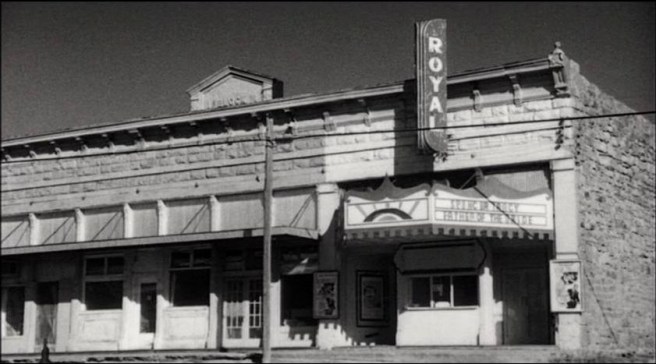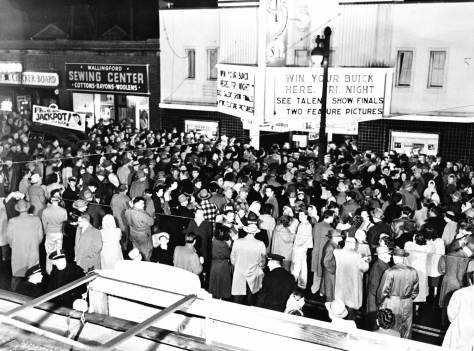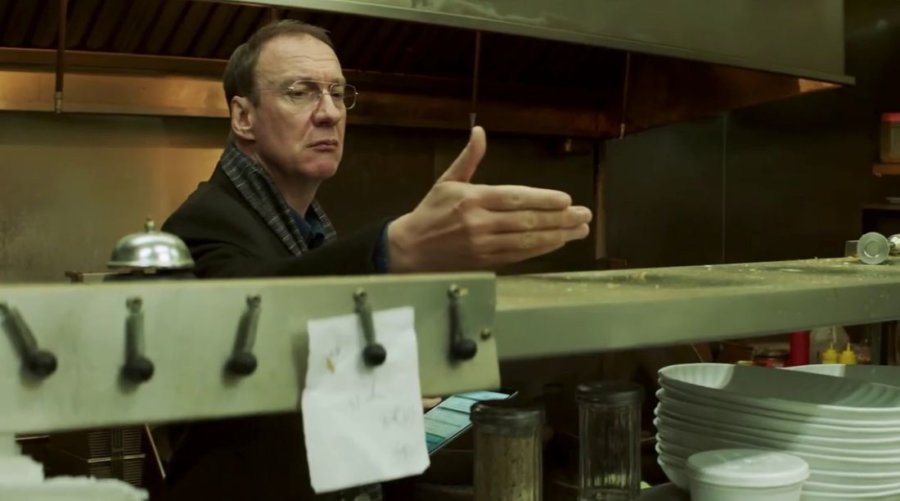

In 2017, my neighborhood theater, Seattle’s legendary Guild 45th shut down. I took the above photo about a month ago. It breaks my heart to witness the results of 3 years of dilapidation. The witless taggers surely have no clue as to its history.
Sadly that blank marquee could portend the future of theaters, period. From Variety:
[Film critic Peter DeBruge] I saw “Tenet” in a theater […] and it was an unnerving experience. I understand why many people don’t feel comfortable taking the risk. I caught COVID back in early March, so I was operating on the principle that I must have at least some protection from the antibodies — and if that’s not the case, then we can kiss the idea of an effective vaccine goodbye. After driving all the way down to a Regal Cinemas in Orange County, I was disappointed by the way the dozen or so people in that enormous RPX auditorium were all clustered in the center with just a single empty-seat buffer between them. What’s more, nearly everyone had bought concessions, treating an $8 soda as a ticket to remove their masks for the entire film, whether or not they were actively eating or drinking at the time. […] I found myself distracted by the question of whether I could get re-infected by all these inconsiderate fans surrounding me.
DeBruge’s observation regarding the “inconsiderate fans” resonates with me, because that is my personal greatest fear about returning to movie theaters: my innate distrust of fellow patrons. While I haven’t worked out since March, it’s the same trepidation I have for returning to my gym. After a 5-month closure, they sent me an email in early August:
We have good news! We are re-opening the rest of our clubs in Washington on Monday, August 10th at 6am. Thank you for your patience, loyalty and support while waiting for this to happen! You have been missed and we are looking forward to welcoming you back in person. While closed, we’ve been working on changes aimed at making our clubs the safest place you can work out.
The email continued with a 12-point list of caveats and precautions and reassurances and meow-meow and woof-woof, but the paragraph at the bottom was a deal-breaker:
We also encourage you to help keep yourself and your fellow members safe by familiarizing yourself with, and following, current state and local guidelines. As these guidelines stress, please do not visit the club if you are sick or experiencing COVID-19 symptoms, and consider postponing your use of the club if you are an at-risk individual.
Thanks, but no. I can trust myself to adhere to a common-sense approach, but it’s been my observation throughout this COVID-19 crisis that everybody isn’t on the same page in regards to taking the health and safety of fellow humans into consideration.
OK. I’m being too polite. This may be an exclusively “American” problem at this point:
[Variety’s executive editor of film and media Brent Lang] The problem is that [the film industry] needs rescuing now — it doesn’t have time to evolve into a high-end indulgence. Just as our libertarian-leaning nation was poorly suited to deal with a pandemic that probably demanded a massive government response to curb the outbreak, so too is hyper-conglomerated Hollywood poorly positioned to meet this current crisis.
[…]
[Peter DeBruge] What’s frustrating to me right now is that the studios won’t even show [their big-budget releases] to press. Variety is an international publication, and we’ve always reviewed movies whenever they open in the world. But Warner Bros., Disney and even STX won’t show their films to American critics, either by link or in safe, limited-capacity screenings. But they will show them to critics abroad. What’s the difference? How is London any safer than Las Vegas for “Tenet” or Pixar’s “Soul”? Private screening rooms have been operating in Los Angeles since at least April, and I’ve been to eight in-theater movies in as many weeks. It is possible, and I can attest: The safe but solitary at-home experience is no comparison.
[Film critic Owen Gleiberman]: Peter, that’s just one more example of the cognitive dissonance factor. Why show movies to critics abroad and not in the U.S.? Because the very idea of seeing a movie on the big screen in America has been tainted by COVID. No one is questioning that the experience needs to be made supremely safe. Yet there’s a perception-and-reality dynamic at work. Some people are scared to go back to the movies, but the larger issue is that between the streaming revolution, the rise of COVID, and the fact that so many viewers have been grousing about the theater experience for years (the ads, the cell phones, the sticky floors — we all know the mythic litany of complaints), the notion that going out to a movie simply isn’t worth the trouble has taken root.
But that’s a perception; it’s not a reality. It’s something that can change if we have the will to change it. This is an issue so layered it goes right to the top — by which I mean, it could be profoundly influenced by the presidential election. If Biden and the Democrats win big, I could easily envision them mobilizing to find the funds that could help sustain and ultimately save movie theaters; whereas Trump and the Republicans aren’t interested in saving anything but themselves. Years from now, we’ll look back on this moment not only as a health and financial and political crisis, but as one that raised essential cultural questions. Such as: Does this culture still believe in movie going?
Well, Mr. Gleiberman…I still believe in movie going. I miss sticky floors, the smell of stale popcorn, and paying $8 for a Diet Coke with too much syrup and too little CO2. With that in mind, I’m re-posting my 2017 tribute to the Guild 45th (sorry about the 1000-word intro. Think of it as the cartoon before the movie). Have you found a good seat? Lights down. Psst: Remember to vote on November 3rd…vote as if the future of your favorite neighborhood theater depended on it. OK, previews are starting. Shh…
(The following piece was originally posted on Digby’s Hullabaloo on June 17. 2017)

This is the song at the end of the movie
When the house lights go on
The people go home
The plot’s been resolved
It’s all over
– Joan Baez
“How tall was King Kong?” asks Eli Cross (Peter O’Toole), the larger-than-life director of the film-within-the-film in Richard Rush’s 1980 black comedy, The Stunt Man. Once you discover that King Kong was but “three foot, six inches tall”, it’s clear Cross’s query is code for a bigger question: “What is reality?” Or perhaps he’s asking “What is film?” Is film a “ribbon of dreams” as Orson Welles once said?
Those are questions to ponder as you take Rush’s wild ride through the Dream Factory. Because from the moment that its protagonist, a fugitive on the run from the cops (Steve Railsback) tumbles ass over teakettle onto Mr. Cross’s set, where he is filming an art-house World War I drama, his (and our) concept of what is real and what isn’t becomes diffuse.
Despite lukewarm critical reception, it is now considered a classic. A 43-week run at the Guild 45th Theater in Seattle (booked by Rush himself, out of his frustration with the releasing studio’s lackluster support) is credited for building word of mouth and assuring the film’s cult status. There is symbiosis in that story (recounted in Rush’s 2000 documentary, The Sinister Saga of Making the Stunt Man); for as surely as The Stunt Man is a movie for people who love movies, the Guild is the type of “neighborhood theater” that people who love movies fall in love with.
The Guild’s buff-friendly vibe stems from the ethos established by former owner-operator Randy Finley. As Matthew Halverson writes in his 2009 Seattle Met article, “The Movie Seattle Saved”:
Randy Finley didn’t like to take chances when booking movies for the Guild 45th Theatre. He took it so seriously that during his 18 years as owner of Seattle’s Seven Gables Theatres chain, he recruited a small cadre of film-buff confidantes who would join him at screenings and then debate whether what they’d seen met Seven Gables’ standards: Could it generate compelling word of mouth? Would it get great critical support? Did they like the people behind the picture? He took a lot of pride in having run movies like “The Black Stallion” and “Harold and Maude” in his theaters when others wouldn’t. And he took even more pride in turning them into art house hits. “If you went to the Guild 45th when I was booking it,” Finley says, “you would walk out thinking you’d just seen one of the best pictures of the year—if not the best.”

The Guild originally opened circa 1920; it was called The Paramount until the Seattle Theater (downtown) adapted the name in 1930. It went through several ownership changes (Finley purchased it in 1975, adding the venue to his local Seven Gables chain). In 1983, Finley added a smaller auditorium two doors down (The Guild II). In 1989, both theaters (along with the rest of the Seven Gables properties) were sold to Landmark, who have run them ever since.
That is…until this happened:
[From The Stranger Slog]
On Monday afternoon, Griffin Barchek, a rising junior at UW, headed to Wallingford to work a shift at the Guild 45th, as he had been doing roughly 30 hours a week for the past year-and-a-half. He heard the bad news before he even stepped inside. “I was the second person to get there,” Barchek said. “I was told immediately by a disgruntled co-worker outside. Then there was a sign on the counter that said ‘We’re closed for renovations.’”
Though he had no hard evidence to support the hypothesis, he believes the sign is a pipe dream. “Renovations are very unlikely,” he speculated. “It’s probably just closed for good.”
Once inside, Barchek said a representative from Landmark’s corporate office was on hand to inform him and his co-workers that both the Guild and the Seven Gables would be closed indefinitely (“for renovations”), that their services were no longer required, and that they’d all be receiving three weeks’ severance. Barchek said he earned the $15/hr minimum wage for his work as an usher, in the box office, and behind the concessions counter.
“She just kept saying ‘I’m sorry’ and kind of making a duck face,” he said of the Landmark representative. (As has been the case with all press inquiries regarding the sudden closure of these theaters, Landmark has refused to comment beyond saying they are closed for renovations.)
I was blindsided by this myself. Last Sunday, I was checking the listings, looking for something to cover for tonight’s weekly film review (preferably something/anything that didn’t involve aliens, comic book characters, or pirates), and was intrigued by Sofia Coppola’s remake of The Beguiled. Being a lazy bastard, I was happy to discover that the exclusive Seattle booking was at my neighborhood theater (the Guild 45th!), which is only a three-block walk from my apartment.
Imagine my surprise when I went to their website for show times and was greeted by this message: “The Seven Gables and Guild 45th Theaters have closed. Please stay tuned for further details on our renovation plans for each location. During the down time, we look forward to serving you at the Crest Cinema Center.” The Crest (now Landmark’s sole local venue open for business) is another great neighborhood theater, programmed with first-run films on their final stop before leaving Seattle (and at $4 for all shows, a hell of a deal). But for how long, I wonder?
It’s weird, because I drive past the Guild daily, on my way to work; and I had noticed that the marquees were blank one morning last week. I didn’t attach much significance to it at the time; while it seemed a bit odd, I just assumed that they were in the process of putting up new film titles. Also, I’ve been receiving weekly updates from the Landmark Theaters Seattle publicist for years; last week’s email indicated business as usual (advising me on upcoming bookings, available press screeners, etc.), and there was absolutely no hint that this bomb was about to drop.
Where was the “ka-boom”?! There was supposed to be an Earth-shattering “ka-boom”. Oh, well.
It would appear that the very concept of a “neighborhood theater” is quickly becoming an anachronism, and that makes me feel sad, somehow. Granted, not unlike many such “vintage” venues, the Guild had seen better days from an aesthetic viewpoint; the floors were sticky, the seats less than comfortable, and the auditorium smelled like 1953…but goddammit, it was “my” neighborhood theater, it’s ours because we found it, and now we wants it back (it’s my Precious).
My gut tells me the Guild isn’t being “renovated”, but rather headed for the fires of Mount Doom; and I suspect the culprit isn’t so much Netflix, as it is Google and Amazon. You may be shocked, shocked to learn that Seattle is experiencing a huge tech boom. Consequently, the housing market (including rentals) is tighter than I’ve ever seen it in the 25 years I’ve lived here.
The creeping signs of over-gentrification (which I first started noticing in 2015) are now reaching critical mass. Seattle’s once-distinctive neighborhoods are quickly losing their character, and mine (Wallingford) is the latest target on the urban village “up-zoning” hit list. Anti-density groups are rallying, but I see the closure of our 100 year-old theater as a harbinger of ticky-tacky big boxes.

Some of my fondest memories of the movie-going experience involve neighborhood theaters; particularly during a 2 ½ year period of my life (1979-1981) when I was living in San Francisco. But I need to back up for a moment. I had moved to the Bay Area from Fairbanks, Alaska, which was not the ideal environment for a movie buff. At the time I moved from Fairbanks, there were only two single-screen movie theaters in town. To add insult to injury, we were usually several months behind the Lower 48 on first-run features (it took us nearly a year to even get Star Wars).
Keep in mind, there was no cable service in the market, and VCRs were a still a few years down the road. There were occasional midnight movie screenings at the University of Alaska, and the odd B-movie gem on late night TV (which we had to watch in real time, with 500 commercials to suffer through)…but that was it. Sometimes, I’d gather up a coterie of my culture vulture pals for the 260 mile drive to Anchorage, where there were more theaters for us to dip our beaks into.
Consequently, due to the lack of venues, I was reading more about movies, than actually watching them. I remember poring over back issues of The New Yorker at the public library, soaking up Penelope Gilliat and Pauline Kael; but it seemed requisite to live in NYC (or L.A.) to catch all of these cool art-house and foreign movies they were raving about (most of those films just didn’t make it out up to the frozen tundra). And so it was that I “missed” a lot of 70s cinema.
Needless to say, when I moved to San Francisco, which had a plethora of fabulous neighborhood theaters in 1979, I quickly set about making up the deficit. While I had a lot of favorite haunts (The Surf, The Balboa, The Castro, and the Red Victorian loom large in my memory), there were two venerable (if a tad dodgy) downtown venues in particular where I spent an unhealthy amount of time in the dank and the dark with snoring bums who used the auditoriums as a $2 flop: The Roxie and The Strand.
That’s because they were “repertory” houses; meaning they played older films (frequently double and triple bills, usually curated by some kind of theme). That 2 ½ years I spent in the dark was my film school; that’s how I got caught up with Stanley Kubrick, Martin Scorsese, Robert Altman, Hal Ashby, Terrence Malick, Woody Allen, Sidney Lumet, Peter Bogdanovich, Werner Herzog, Ken Russell, Lindsay Anderson, Wim Wenders, Michael Ritchie, Brian De Palma, etc.
Of course, in 2017 any dweeb with an internet connection can catch up on the history of world cinema without leaving the house…which explains (in part) why these smaller movie houses are dying. But they will never know the sights, the sounds (the smells) of a cozy neighborhood dream palace; nor, for that matter, will they ever experience the awesomeness of seeing the classic films as they were originally intended to be seen-on the big screen. Everybody should experience the magic at least once. C’mon-I’ll save you the aisle seat.
Previous posts with related themes:
Nice Sweaters: Adieu to TV’s At the Movies
More reviews at Den of Cinema
—Dennis Hartley



















